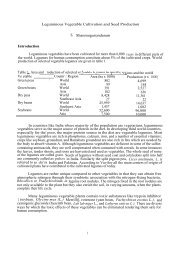Management of the Diamondback Moth and Other Crucifer Insect ...
Management of the Diamondback Moth and Other Crucifer Insect ...
Management of the Diamondback Moth and Other Crucifer Insect ...
You also want an ePaper? Increase the reach of your titles
YUMPU automatically turns print PDFs into web optimized ePapers that Google loves.
(Gupta <strong>and</strong> Thorsteinson 1960; reviewed in Sarfraz et al.2006).The diamondback moth was discovered on sugar snappeas (Pisum sativum, Fabaceae) in <strong>the</strong> Naivasha region<strong>of</strong> Kenya in 1999 (Loehr 2001). The strain collectedfrom this infestation (DBM-P) is able to completedevelopment on both pea plants <strong>and</strong> <strong>the</strong> ancestralBrassica plants, indicating that a host range expansionra<strong>the</strong>r than a host shift has occurred (Loehr <strong>and</strong> Gathu2002). Adult females <strong>of</strong> <strong>the</strong> pea strain retain a preferenceto lay eggs on cruciferous plants, but <strong>the</strong>y are more likelythan o<strong>the</strong>r strains to lay eggs on pea plants in choice <strong>and</strong>no-choice experiments (Henniges-Janssen et al. 2011).Loehr <strong>and</strong> Gathu (2002) proposed that survival on peawas related to “<strong>the</strong> ability to initiate feeding without <strong>the</strong>normal stimuli present in crucifers.” Subramanian <strong>and</strong>Loehr (2006) conducted an experiment <strong>of</strong> host plantchoice <strong>of</strong> neonates, <strong>and</strong> we would like to exp<strong>and</strong> fromthis work. Thus, <strong>the</strong> additional aims <strong>of</strong> this study are tobetter characterize <strong>the</strong> behavioral componentscontributing to <strong>the</strong> host range expansion in <strong>the</strong> pea strain<strong>and</strong> determine <strong>the</strong> inheritance <strong>of</strong> those components.MATERIALS AND METHODSPetri dish assaysObservational assays <strong>of</strong> a duration <strong>of</strong> 5 minutes wereconducted to measure attraction to <strong>the</strong> two different hostplants in choice <strong>and</strong> no-choice scenarios. Observationswere made every 30 seconds <strong>and</strong> included whe<strong>the</strong>r aneonate reached a particular leaf disc <strong>and</strong> whe<strong>the</strong>r aneonate left its respective sector (Figure 1). In this way,host searching behavior can be characterized by bothspeed <strong>and</strong> level <strong>of</strong> directed movement.walk (Figure 1C). This was done because some neonatesprefer to hold an inverted orientation, <strong>and</strong> <strong>the</strong> smallvertical space allowed neonates to do so. In <strong>the</strong> center <strong>of</strong><strong>the</strong> arena was placed a leaf disc (14mm) <strong>of</strong> ei<strong>the</strong>rcabbage or pea, <strong>and</strong> a ring <strong>of</strong> moist filter paper (width1cm) was placed around <strong>the</strong> outer edge both for moisture<strong>and</strong> as a deterrent to neonate escape. Neonates wereplaced (15mm) away from <strong>the</strong> edge <strong>of</strong> <strong>the</strong> arena <strong>and</strong>were observed four at a time per family.ChoiceThe arena was set up similarly to <strong>the</strong> no-choiceexperiments, but with neonates beginning <strong>the</strong> assayinside a 15 mm circle in <strong>the</strong> center <strong>and</strong> with leaf discsplaced 3mm from <strong>the</strong> edge (Figure 1B). Two cabbageleaf discs <strong>and</strong> two pea leaf discs (12mm) were placedopposite each o<strong>the</strong>r, respectively. Two or four neonatesper family were observed at a time; observations are <strong>the</strong>same as described above. Most neonates made a choicewithin <strong>the</strong> 5 minute assay; <strong>the</strong> 7 <strong>of</strong> 76 total neonates thatdid not make a choice were excluded from analyses. In<strong>the</strong>se choice assays, <strong>the</strong> petri dish arenas were checked24 h after <strong>the</strong> initial observation to see whe<strong>the</strong>r <strong>the</strong>proportion <strong>of</strong> neonates on <strong>the</strong> respective leaf discs was<strong>the</strong> same.Vial assayBased on results from <strong>the</strong> short term petri dish assays, anassay <strong>of</strong> longer duration on individual neonates wasdevised. Plastic vials with a height <strong>of</strong> 2.5 cm <strong>and</strong> width<strong>of</strong> 1.2 cm contained a leaf disc <strong>of</strong> cabbage <strong>and</strong> pea atei<strong>the</strong>r side. Leaf discs were r<strong>and</strong>omized with regard toposition in <strong>the</strong> vial. Neonates were placed on <strong>the</strong> side <strong>of</strong><strong>the</strong> vial between <strong>the</strong> leaf discs <strong>and</strong> were checked 24 hlater for <strong>the</strong>ir choice. Vials were placed on <strong>the</strong>ir side for<strong>the</strong> assay so that preferred orientation <strong>of</strong> neonates wasnot a confounding factor in <strong>the</strong> experiment.To test applicability <strong>of</strong> this assay for use as a marker,results were compared to survival data in two ways.First, <strong>the</strong> percentage <strong>of</strong> neonates per family that chose<strong>the</strong> pea disc was compared to <strong>the</strong> percent <strong>of</strong> individualsper family that were able to complete development topupation on a diet <strong>of</strong> pea leaves. Individuals weresiblings <strong>and</strong> not <strong>the</strong> same ones used to test survival. In aseparate set <strong>of</strong> replicates, however, larvae were reared topupation on <strong>the</strong>ir choice as neonates.Figure 1. Diagram <strong>of</strong> <strong>the</strong> petri dish assays (notnecessarily to scale). A) No choice assay; B) Choiceassay; C) Pr<strong>of</strong>ile view <strong>of</strong> <strong>the</strong> no choice assay.No choiceThe arena consisted <strong>of</strong> an inverted lid, into which wasplaced <strong>the</strong> bottom <strong>of</strong> <strong>the</strong> petri dish (Figure 1A), leavingabout 1-2mm vertical space in which <strong>the</strong> neonates couldRESULTS AND DISCUSSIONPetri dish assaysNo choiceThere was no difference in attractiveness <strong>of</strong> <strong>the</strong> two hostplants between <strong>the</strong> two host races. Equal proportions <strong>of</strong><strong>the</strong> cabbage strain <strong>and</strong> <strong>the</strong> pea strain go to both <strong>the</strong>cabbage (χ 2 =0.066, P=0.797, n=52) <strong>and</strong> pea leaf discs(χ 2 =0.265, P=0.607, n=52) in <strong>the</strong> 5 minute assay (Figure2). In a test for level <strong>of</strong> directed movement, i.e. howmany neonates left <strong>the</strong>ir sector, <strong>the</strong> pea strain exhibited4 AVRDC - The World Vegetable Center
















